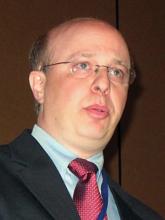SAN FRANCISCO – Intermittent courses of high-dose inhaled budesonide were as effective and as safe as daily low-dose inhaled budesonide in wheezing toddlers but exposed them to a lower cumulative dose of the corticosteroid in a year-long study of 278 children.
The two groups did not differ significantly in the frequency of exacerbations that required systemic corticosteroids, the frequency or severity of respiratory tract illness, the number of urgent or emergent visits for care, or other efficacy and safety measures, Dr. Leonard B. Bacharier and his associates reported at the annual meeting of the American Academy of Allergy, Asthma, and Immunology.
Children in the daily low-dose budesonide group, however, were exposed to more than three times the cumulative dose of budesonide, compared with the intermittent high-dose therapy group – 150 mg vs. 46 mg.
The multicenter, randomized, double-blind, placebo-controlled trial, called the Maintenance Versus Intermittent Inhaled Steroids in Wheezing Toddlers (MIST) study, is the last of eight clinical trials performed by the National Heart, Lung, and Blood Institute’s Childhood Asthma Research and Education Network.
The NHLBI’s 2007 "Expert Panel Report 3: Guidelines for Diagnosis and Management of Asthma" recommended using daily low-dose inhaled corticosteroids to treat children who have a positive modified Asthma Predictive Index.
The MIST study is the first to compare the currently recommended daily low-dose regimen with the intermittent high-dose regimen, said Dr. Bacharier of Washington University, St. Louis.
On the basis of the MIST results, Dr. Bacharier and his associates recommended instead that clinicians consider using intermittent high-dose inhaled corticosteroids in the subset of children identified in the MIST study, who were not the most severe asthma cases. They suggested starting a 7-day course of high-dose budesonide early during respiratory tract illnesses in wheezing children who have a positive modified Asthma Predictive Index, have had at least one exacerbation in the past year, use albuterol less than 3 days per week, and have had no more than one night awakening in the prior 2 weeks.
The study enrolled children 12-53 months of age, nearly half of whom were in the lower age range of 12-32 months. All children had a history of at least four wheezing episodes in the prior year (or at least three if they’d had 3 months or more of asthma controller therapy) and a positive modified Asthma Predictive Index. Each child also had at least one severe exacerbation that required systemic corticosteroids or an unscheduled urgent or emergent visit or hospitalization in the previous year.
The study excluded children who had more than two hospitalizations for wheezing or more than six courses of oral corticosteroids.
During a 2-week run-in period, all children used a nebulized placebo nightly and albuterol as needed. During this period, children who had persistent asthma symptoms or who did not follow the protocol for more than 25% of days also were excluded.
The children were then randomized for 52 weeks of therapy. The daily low-dose budesonide group used 0.5 mg of nebulized budesonide once daily at night except during respiratory tract illness, when they switched to "respiratory tract illness kits" that gave them nebulized placebo in the morning and 0.5 mg of budesonide at night for 7 days. The intermittent high-dose budesonide group used nebulized placebo once daily at night except during respiratory tract illness, when their kits gave them 1 mg of budesonide in the morning and at night for 7 days.
Previous studies have shown that daily inhaled corticosteroids have "a small but statistically significant class effect on reducing linear growth in preschool-aged children, which only partially reverses after discontinuation of study treatments," which was a main reason for studying the intermittent-therapy alternative, Dr. Bacharier said.
In the MIST study, children in the daily-therapy group grew an average of 7.76 cm, compared with 8.01 cm in the intermittent-therapy group, but the 0.25-cm greater growth with intermittent therapy was not statistically significant.
There were no significant differences between groups in baseline characteristics, adherence to therapy during the study, declines in levels of exhaled nitric oxide, time to first exacerbation, or time to treatment failure.
The NHLBI funded the study. AstraZeneca provided the budesonide and placebo for the study. Dr. Bacharier has been a consultant for AstraZeneca (which markets budesonide), Merck, and Novartis, and has received honoraria from GlaxoSmithKline.


